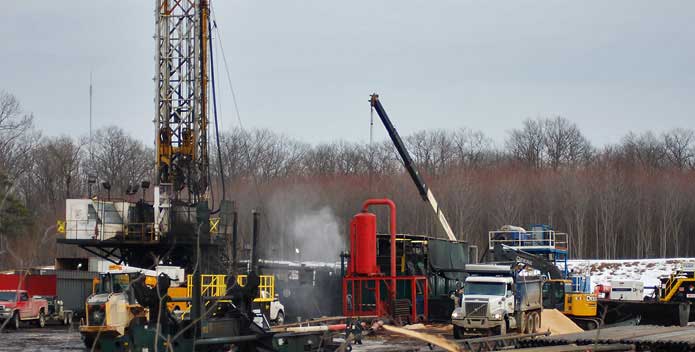About Marcellus and Taylorsville Shale Formations and the Hydraulic Fracturing Process
The Marcellus Shale rock formation—lying beneath parts of New York, Pennsylvania, Ohio, Maryland, Virginia, and West Virginia—holds huge supplies of cleaner-burning natural gas. Shale containing natural gas has also been found in the Taylorsville basin, which runs below parts of southeastern Maryland and northwestern Virginia (see sidebar map). In a process called hydraulic fracturing, drilling companies inject millions of gallons of water—mixed with a variety of chemicals and sand—into the shale at high pressure to crack the rock and release the natural gas.
Different wells need different amounts of fluids, ranging from 1 to 9 million gallons. Once the gas has been freed, some of that water, generally between 20-50 percent, comes back to the surface. That flowback is contaminated with salt, minerals, chemicals, and, in some locations, naturally-occurring radioactive isotopes. The remainder remains deep underground where it may eventually affect groundwater aquifers and local streams. Another method of disposal is to pump the fluids into a large, lined impoundment ponds or storage tanks, to be vacuumed up later and shipped by fleets of tanker trucks to a wastewater plant. Increasingly, some companies "recycle" portions of the fluids for use in other wells.
The Concerns About Natural Gas Drilling
The environmental, human health, and community challenges presented by natural gas drilling cannot be underestimated. Some of these include:
- Contamination of groundwater, drinking water, and local streams with toxic chemicals, high levels of salt, and even naturally-occurring radioactive materials.
- Vital habitat, forest, and pristine public lands, converted to well pads, pipelines, roads, impoundments and other infrastructure.
- Accelerated stormwater runoff—and its resulting increase in nutrient and sediment levels in nearby streams—as extensive areas are cleared, roads are degraded, and soils are compacted.
- Increased air pollution due to the hundreds to thousands of tanker truck trips necessary to bring water and equipment to a single well into production, as well as thousands of compressor stations, potentially leaking methane and toxic gases into the air.
- Costly stress on roads, bridges, and other infrastructure from fleets of tanker trucks.
- If wells are abandoned, inadequate bonding may not cover the cost of properly plugging a well, leaving the state to cover the remaining costs.
- Outdated or inadequate requirements for how far wells must be placed from drinking water supplies, streams, wetlands and floodplains.
These and other challenges underscore the need for comprehensive analysis of the environmental and quality of life impacts of long term drilling across the Chesapeake Bay watershed.
CBF's Position
Natural gas drilling within portions of the Chesapeake Bay watershed has been occurring for decades. In recent years, however, new techniques—such as hydraulic fracturing or 'fracking'—have made once unobtainable underground natural gas sources accessible. Now vast areas of some of the most pristine and sensitive habitats within the Bay watershed face an ever growing wave of industrialization.
Because of the magnitude and intensification of natural gas drilling and the associated infrastructure it brings, unconventional gas development threatens to have a profound impact on the landscape of the Bay watershed for generations to come. The cumulative impacts from the construction and operations of well pads, access roads, pipelines, and compressor stations, as well as the water quality impacts and air pollution from trucks, well drilling, and ships may pose a risk to the Chesapeake Bay and the rivers and streams that feed into it.
CBF has not taken a position against natural gas development, nor have we called for a permanent ban on gas development in the region. Instead, we have embraced the precautionary principle. Our over-arching goal is to ensure that future energy development in the Chesapeake Bay region takes place in as safe and environmentally responsible a manner as possible. We have joined others in calling for a federal study of cumulative impacts of Marcellus shale development in the region and active participation in state policy initiatives (particularly in Pennsylvania).




